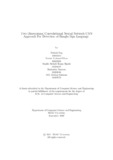Two dimensional convolutional neural network CNN approach for detection of Bangla sign language
Date
2022-09-28Publisher
Brac UniversityAuthor
Nag, PollockKhan, Tamim Mahmud
Biplob, Shaikh Mehedi Hasan
Barmon, Rachayita
Rahman, MD. Minhaj
Metadata
Show full item recordAbstract
Sign language is known as the primary communication medium for deaf and mute
people. But the lack of available resources and a steep learning curve deter the
average person from learning it making communication with the mute and deaf
difficult. This problem creates an opportune place for the application of machine
learning which has given rise to our emerging field. A large number of papers with
high accuracy have already been published for English, French, and other languages.
But the number of papers on its application for Bangla Sign language is few. Most
of the researchers use SVM, ANN or KNN as classifiers. We chose CNN because it is
excellent at high accuracy image classification. In this paper we use a large dataset
consisting of 30 classes with 500 images each totalling to about 15000 images of
bangla sign alphabets. Previous works were done only on 10 classes. We began
work on those 10 bangla alphabets and later increased the number of classes to 30.
We tested the accuracy’s of pre trained CNN models such as DenseNet201,VGG16,
InceptionV3, Resnet50, MobileNetV2, InceptionResnet, EfficientnetB2 along with
our custom CNN model and were able to achieve 97.97%, 96%, 96.22%, 56.44%,
90%, 94%, 4%,98.3 % train accuracy and 86.43%, 88%, 88.33%, 54.50%, 60%, 53%,
4.2%,87% validation accuracy respectively. Our custom CNN model has consistently
given better training and validation accuracy than any pre-trained model with lesser
layers which in turn require less computations making for a lighter and faster model
while maintaining high accuracy.

